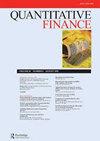How does price (in)efficiency influence cryptocurrency portfolios performance? The role of multifractality
IF 1.4
4区 经济学
Q3 BUSINESS, FINANCE
引用次数: 0
Abstract
AbstractThis paper proposes a new investment strategy in the cryptocurrency market based on a two-step procedure. The first step is the computation of the asset's levels of efficiency in an universe of cryptocurrencies. Price returns efficiency degrees are measured by their corresponding levels of multifractality, obtained by the multifractal detrended fluctuation analysis method. The higher the multifractality, the higher the inefficiency in terms of the weak form of market efficiency. Cryptocurrencies are then ranked in terms of efficiency. The second step is the construction of portfolios under the Markowitz framework composed of the most/least efficient digital coins. Minimum variance, maximum Sharpe ratio, equally weighted and (in)efficient-based portfolios were considered. The former strategy is also proposed, where the weights are computed proportionally to the assets levels of (in)efficiency. The main findings are: cryptocurrency price returns are multifractal and their levels of (in)efficiency change over time; returns exhibit left-sided asymmetry, which implies that subsets of large fluctuations contribute substantially to the multifractal spectrum; in bull markets portfolios with the least efficiency assets provided a better risk–return relation; in periods of high volatility and high price depreciation (bear market) a better performance is associated with the portfolios composed by the more efficient cryptocurrencies.Keywords: Portfolio allocationCryptocurrencyMarket efficiencyMF-DFAMultifractalityJEL Classifications: G14G11 Disclosure statementNo potential conflict of interest was reported by the author(s).Notes1 Markiel and Fama (Citation1970) and Titan (Citation2015) are surveys regarding the empirical analysis of the weak form of market efficiency.2 The Hurst exponent, referred to as the ‘index of dependence’ or ‘index of long-range dependence’, is used as a measure of long-term memory of time series. Originally developed in hydrology and commonly studied in fractal geometry, it relates to the autocorrelations of the time series, and the rate at which these decrease as the lag between pairs of values increases (Hurst Citation1951).3 Traditional nonlinear variance ratio tests or autocorrelation functions are not able to identify multifractal structures. Fractal properties are associated to time series that present heavy tails and long memory. As these features are commonly observed in financial asset price returns (stylized facts), the use of MF-DFA appears as a suitable technique to evaluate random walk properties in such series, as stated by the econophysics literature (Arshad et al. Citation2016, Ali et al. Citation2018, Tiwari et al. Citation2019).4 The works of Mensi et al. (Citation2018), Sukpitak and Hengpunya (Citation2016), Dewandaru et al. (Citation2015), Tiwari et al. (Citation2019), Shahzad et al. (Citation2017), Zhu and Zhang (Citation2018) and Rizvi and Arshad (Citation2017) are examples of using MF-DFA to evaluate the weak form of market efficiency in financial markets, mostly stock markets.5 Ozkan (Citation2021), Diniz-Maganini et al. (Citation2021), Mnif et al. (Citation2020), Naeem et al. (Citation2021), Naeem et al. (Citation2021), Mensi et al. (Citation2020), Choi (Citation2021) and Mensi et al. (Citation2021) also found evidence on the impacts of the COVID-19 pandemic on the level of efficiency in different markets.6 As suggested by Rizvi and Arshad (Citation2014), the scaling range assumed the values of smin=10 and smax=(T/4), where T is the series' number of observations.7 More sophisticated methods for covariance matrix estimation may be used, such as EWMA and multivariate GARCH-family models. However, testing different methodologies for covariances in portfolio selection is beyond the main objective of this work.8 Rebalancing schemes can be considered, however, the identification of the time of rebalancing, as well as the consideration of transaction costs, are complex tasks, being considered as future work due to length limitations.9 Data were collected at https://finance.yahoo.com/.10 All experiments in this work were performed using R software.11 The Hurst exponents, H(q), from q=−4 to q=4 are not presented here due to length limitations but are available upon request.12 It is important to highlight that the year of 2021 is associated with a bear market and this behavior might be associated with the decrease of the level of efficiency of the corresponding cryptocurrencies. However, the analysis of the temporal dynamics of multifractality if out of the scope of this paper.Additional informationFundingThis work was supported by the Brazilian National Council for Scientific and Technological Development (CNPq) under Grant 304456/2020-9; and the Ripple Impact Fund, a donor advised fund of the Silicon Valley Community Foundation, under Grant 2018-196450(5855), as part of the University Blockchain Research Initiative, UBRI.价格(in)效率如何影响加密货币投资组合的表现?多重分形的作用
摘要本文提出了一种新的基于两步法的加密货币市场投资策略。第一步是计算资产在加密货币世界中的效率水平。利用多重分形去趋势波动分析方法得到的多重分形对应的多重分形水平来衡量价格收益效率程度。多重分形越高,市场效率的弱形式效率越低。然后根据效率对加密货币进行排名。第二步是在Markowitz框架下构建由效率最高/最低的数字货币组成的投资组合。最小方差,最大夏普比率,等加权和(in)效率为基础的投资组合被考虑。还提出了前一种策略,其中权重与(in)效率的资产水平成比例计算。主要发现是:加密货币的价格回报是多重分形的,它们的效率水平随着时间的推移而变化;回报表现出左侧不对称,这意味着大波动的子集对多重分形谱有很大贡献;在牛市中,效率最低的资产组合提供了更好的风险收益关系;在高波动性和高价格贬值(熊市)时期,更好的表现与由更有效的加密货币组成的投资组合有关。关键词:投资组合配置加密货币市场效率ymf - dfam多分性jel分类:G14G11披露声明作者未报告潜在利益冲突。注1 Markiel and Fama (Citation1970)和Titan (Citation2015)是关于市场效率弱形式实证分析的调查赫斯特指数,又称“依赖指数”或“长期依赖指数”,用来衡量时间序列的长期记忆。它最初是在水文学中发展起来的,通常在分形几何中进行研究,它涉及时间序列的自相关性,以及这些自相关性随着值对之间的滞后增加而降低的速率(Hurst Citation1951)传统的非线性方差比检验或自相关函数不能识别多重分形结构。分形特性与呈现重尾和长记忆的时间序列有关。由于这些特征通常在金融资产价格回报(程式化事实)中观察到,正如经济物理学文献(Arshad等人)所述,使用MF-DFA似乎是评估此类序列中的随机游走特性的合适技术。Citation2016, Ali等。引文2018,Tiwari等人。Citation2019) 4。Mensi等人(Citation2018)、Sukpitak和Hengpunya (Citation2016)、Dewandaru等人(Citation2015)、Tiwari等人(Citation2019)、Shahzad等人(Citation2017)、Zhu和Zhang (Citation2018)以及Rizvi和Arshad (Citation2017)的作品都是使用MF-DFA来评估金融市场(主要是股票市场)中市场效率弱形式的例子Ozkan (Citation2021)、Diniz-Maganini等人(Citation2021)、mif等人(Citation2020)、Naeem等人(Citation2021)、Naeem等人(Citation2021)、Mensi等人(Citation2020)、Choi (Citation2021)和Mensi等人(Citation2021)也发现了COVID-19大流行对不同市场效率水平影响的证据Rizvi和Arshad (Citation2014)建议,标度范围假设smin=10, smax=(T/4),其中T为序列的观测次数可以使用更复杂的协方差矩阵估计方法,如EWMA和多元garch家族模型。然而,在投资组合选择中测试不同的协方差方法超出了本工作的主要目标可以考虑再平衡方案,但是,确定再平衡的时间以及考虑交易成本是复杂的任务,由于篇幅限制,被认为是今后的工作数据收集于https://finance.yahoo.com/.10,本工作中所有实验均使用R软件进行赫斯特指数,H(q),从q=−4到q=4,由于篇幅限制,这里没有给出,但可根据要求提供需要强调的是,2021年与熊市有关,这种行为可能与相应加密货币效率水平的下降有关。然而,多重分形的时间动力学分析超出了本文的研究范围。本研究由巴西国家科学技术发展委员会(CNPq)资助,基金编号304456/2020-9;Ripple Impact Fund是硅谷社区基金会的捐赠基金,在Grant 2018-196450(5855)下,作为大学区块链研究计划(UBRI)的一部分。
本文章由计算机程序翻译,如有差异,请以英文原文为准。
求助全文
约1分钟内获得全文
求助全文
来源期刊

Quantitative Finance
社会科学-数学跨学科应用
CiteScore
3.20
自引率
7.70%
发文量
102
审稿时长
4-8 weeks
期刊介绍:
The frontiers of finance are shifting rapidly, driven in part by the increasing use of quantitative methods in the field. Quantitative Finance welcomes original research articles that reflect the dynamism of this area. The journal provides an interdisciplinary forum for presenting both theoretical and empirical approaches and offers rapid publication of original new work with high standards of quality. The readership is broad, embracing researchers and practitioners across a range of specialisms and within a variety of organizations. All articles should aim to be of interest to this broad readership.
 求助内容:
求助内容: 应助结果提醒方式:
应助结果提醒方式:


